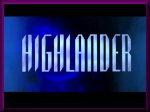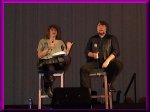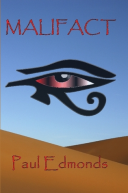



The Pen vs. The Sword - Gillian Horvath & F. Braun McAsh
 Gillian opened the session by saying she was going to be showing the same clips that she had used at the Gathering and at the Anthony de Longis Sword Spectacular. She said that, as writers, they have to put their faith in the hands of the experts and concentrate on telling the story of the fight in the script - for example, Duncan loses initially, but then wins in the end. They try to tell the emotional arc of the sword fight and leave it to the sword master and the actors to work out how they do this.
Gillian opened the session by saying she was going to be showing the same clips that she had used at the Gathering and at the Anthony de Longis Sword Spectacular. She said that, as writers, they have to put their faith in the hands of the experts and concentrate on telling the story of the fight in the script - for example, Duncan loses initially, but then wins in the end. They try to tell the emotional arc of the sword fight and leave it to the sword master and the actors to work out how they do this.
Braun said that Dennis Berry was prone to thinking of new things five minutes before they would roll. He said that, in his first episode, he was given a detailed page and half of the script which outlined the fight. However, factors which determine the fight, such as the location, mean that such descriptions can be largely irrelevant. He said that, in Courage, he had to choreograph a fight that had only 1 sword until right at the end. He said that we know that Duncan will never be killed and that makes it more difficult to make it look like the fight presents him with a real danger.
Gillian said that television operates on the basis that a page of script equals a minute of screen time and so the writers had to fill the space on the page to a length of the fight they wanted. The script was their only means of communicating with Braun on the set and they had to be sure that he would see the feel of what they were after from what was written on the printed page. The fact that he was also an actor made that task easier. Braun said that he needed to know the story of the episode or he couldn't begin to choreograph - when he was working in theatre, he wouldn't normally start to choreograph the fights until after a full week of rehearsal, so that he could see the characters emerging as the actors developed into the role. He said it was important for him for Duncan to always win well, that is to say, honourably, and Duncan wouldn't kill an unarmed opponent. This gave dimension to the character of MacLeod, but challenged him to deliver when he was choreographing the fight. He pointed out that if Duncan cheated and then went on to spout about honour and sacrifice, the audience is left with the perception that this is a character who lies.
We then moved to the first clip they showed, which was the dojo fight between Methos and Duncan in Chivalry. Braun said this is an example of a sword fight with dialogue, where the swords and the words play off against each other. Gillian said that the finished product differed from what they had put down in the script, although it was broadly similar, but it had much more power. Braun said that this was the first time that Peter Wingfield had used a sword two-handed. He said the line in the dialogue about Fabri's technique was actually true, as he had Peter using Italian rapier moves with the katana, implying that Methos doesn't know the use of the katana in the same way that Duncan does. He said that they use aluminium blades for the fighting, but steel blades for the close-ups, referring to them as the fighting sword and the beauty sword. He said that the aluminium blades get nicked very readily and the edge becomes like a hacksaw blade - they could go through as many as six blades for each sword in filming the fight and he pointed out that, when the fight is over, they hadn't had time to change the blade on this occasion and you can see the nicks in the blade that Adrian is holding against Peter's throat.
The next fight they look at was the climactic fight from Revelation 6:8. He said that the script had been written for the fight to take place in a chateau, not in an abandoned submarine base. The rhythm of the fight follows the script, in that both sets of combatants reached the climax of their fight at the same time, but it gave him a headache choreographing the fight, as it takes place across six submarine pens with open walls and both pairs of fighters had to be visible to all cameras the same time. He said that the only one of the Horsemen who had not studied fighting previously was Marcus Testory, who had to learn Caspian's two-handed fighting style. Gillian said that there was one change from the script, in that the deaths of Silas and Kronos were the other way round from how it had originally been written. Braun said that the beheadings reflect the relationship between the characters - Duncan kills Kronos by driving his head along the edge of his blade, holding his own sword stationery and watching what he's doing, whereas Methos kills Silas with a spinning cut that means he has his back to his friend when he kills him, so that he doesn't after actually watch what he's done.
Braun said that there was an EC summit taking place in the hotel during the filming of that episode, with the British Prime Minister, amongst others, in attendance, (prompting Gillian to say "it's real!" remembering that they had fabricated such a conference for Deadly Exposure), but one of the baboons that they had been using had escaped. Braun said he had this vision of Tony Blair answering a knock on the door in the middle of the night, to be faced by one of Silas' monkeys! He had visions of MI5 hunting for the escaped baboon.
The next fight they chose to show us was the end fight from Courage. Braun said that this was one of the more brutal fights and that Bill Panzer had wanted this fight to be savage. This fight was edited for broadcast in several regions, (including the UK), and the version we saw was quite long. Duncan impaled Cullen through the windshield and Cullen managed to cut Duncan's neck at one point. Gillian said this was example of the script not reflecting the dynamics of the fight, as there was a page of Cullen and Duncan waking up, but only two paragraphs for the fight which followed. Braun said that there was one take where Adrian was supposed to roll-out through the back doors of Cullen's van, but someone had forgotten to leave the doors unlocked and as Adrian rolled inside the van, they heard this thud outside. As Duncan climbs over the fence and drops to the other side, Cullen impales him with his sword and Braun said that he had wanted Duncan to be hanging from the fence impaled on the sword at this point. He said he'd choreographed the fight so its general tenor was that Cullen was drunk, but hadn't the strength to kill himself and puts Duncan in the position where he effectively commits suicide.
The next clip was the teaser from Till Death. This is the sequence where Robert and Gina parry with great élan through the halls of their mansion. Braun said it took 12 takes for Jeremy Brudenell to get the shot right where he pulls sheet over the two of them at the end. He also said that they had had problems with the actress playing Gina, as to resume said that she could fight and ride, but she came to the set with a bad back injury and her sword skills were questionable. This is why the only time you see her face, she's standing still, as the rest of fight was done by her stunt double. In fact, the reason why the fight is in the darkness is that Jeremy Brudenell had finished on set and gone home, leaving Braun and the stunt double, Virginie, to do the fight on the slippery floor of the location. He said that only four times in four years had he replaced an actor because he or she either couldn't fight or was injured. He pointed out that he had given Robert and Gina "his and hers" swords.
Next was the Roman battle scene from Take Back The Night. Braun said that he was given 50 stuntmen and three hours on the day of filming in order to get the battle sorted. He said every move was choreographed, apart from the stuntman who managed to injure his partner by improvising after they had moved out of camera shot. He said that the shield formation used by the Roman soldiers was historically accurate and was known as a Testudo, which means tortoise.
They played the teaser from Dramatic License and Braun said that this was a complete Errol Flynn pastiche. He was a little frustrated by the gazebo that the fight takes place in and around, as it obscures many of the moves. He said it was as much fun to film as it looked, but you have to take things seriously even when you're filming a comic fight, as people can still get hurt. He said it was a lot of fun to do the over-the-top clichés knowingly, including the girl who is constantly getting in Duncan's way.
He said that, at the beginning of Forgive Us Our Trespasses, they had wanted to redeem Amanda's sword fighting capabilities, particularly as she had been shown losing to Kalas and Luther. Gillian said that they received a phone call asking them to write a close fight, which they'd returned as a page and half. They were surprised when the dailies appeared in Los Angeles with the fight filmed as it is in the episode. Braun said that a fight requires rehearsal time and Elizabeth arrived on the day of filming, so there was no possibility of rehearsing it and therefore of the fight being filmed. He said that fight can weaken the credibility of the characters and they tried to avoid changes in that way. Gillian asked why the script had been changed, as in the "mind your own business" scene, the script called for Methos to have a club in his hand. Braun said that Methos clubbing Duncan was a bit like the Three Stooges and they felt that shooting him was the only way to keep Duncan dead long enough for Methos to have the fight with Keane. Braun said he felt that fight showed something about Methos' sense of honour - Methos may have knifed Keane in the groin at the end of the fight, but we know that he went into the fight with a gun in his pocket and if he had simply wanted to kill him, he could have shot Keane straightaway. He said he felt that the impact of Methos' intervention in To Be, where he shoots one of O'Rourke's merry men, was diminished as a surprise by the fact that we saw him killing Walker's goons in Indiscretions. Turning back to the fight with Stephen Keane, Braun said that the script said that Keane was good, possibly as good as Duncan, so he had Methos deliberately stumble so that he could knife Keane.
The final sequence they showed us came under the heading of "best-laid plans". He said that Adrian Paul had enjoyed working with Anthony de Longis so much when they were filming Blackmail that he had wanted Anthony's character to survive. They decided that they'd have Anthony back in a future episode, as a different character, and he went on their "wish-list". Gillian said that they had never done a script based on a style of sword fighting, as they always went for the emotional story and left the fight generic, for Braun to choreograph. In the case of Duende, Anthony had both the technique and an outline of the story for the flashback. Braun said that he had been talking to Tony, who had been researching the Spanish style of the Mysterious Circle and they decided to "go large" on this. The fact that the fight at the end would be with rapiers meant they couldn't use aluminium blades and the blade that Anthony was using had spiral edge which macerate the wound it makes, so that the wound can't be close. Gillian said that she called Braun for notes on the style, so the script would make sense. Adrian learn the fight from Braun and Anthony the day before they filmed it. All went well, until they got on set and it started to rain. The Mysterious Circle itself was painted on plywood and Braun had specifically asked for sand to be mixed in with the paint, knowing that Anthony and Adrian would be wearing dress shoes. They had also used plastic tape to put lines on, instead of painting them in. These lines represented the most direct route to the vulnerable points of the opponent and he said he was quite surprised when he saw an overhead shot of the fight at how closely the swords of the two actors followed the lines. He said that the rain in some shots was invisible and had to be painted him in post-production. Of the fight, he said that the Mysterious Circle is intended to show options open to the fighter and Duncan's eventual victory shows that he has learnt his lesson from Consone and has learnt to think outside the circle. He said that the beheading with the daggers wouldn't work, but it gave a dramatic image to end the fight, which is what he'd been after.
